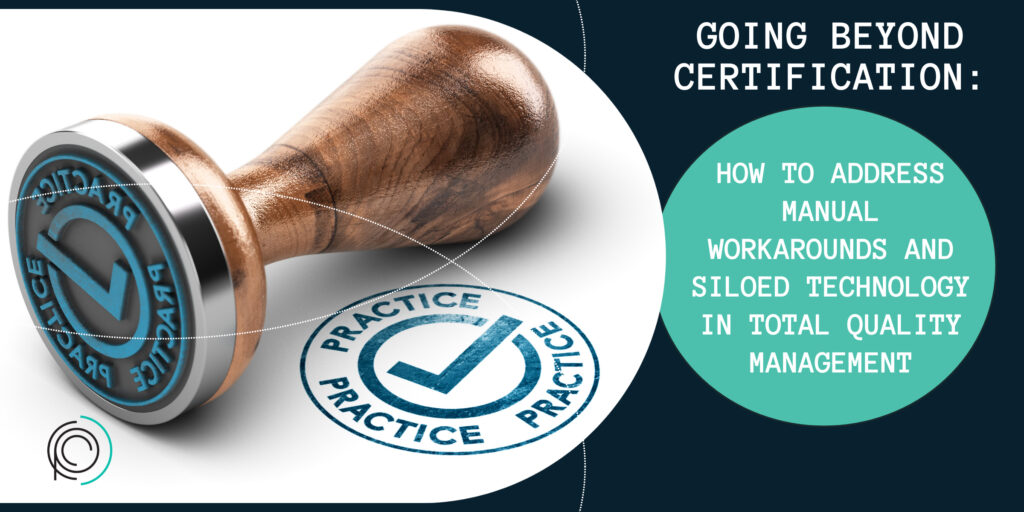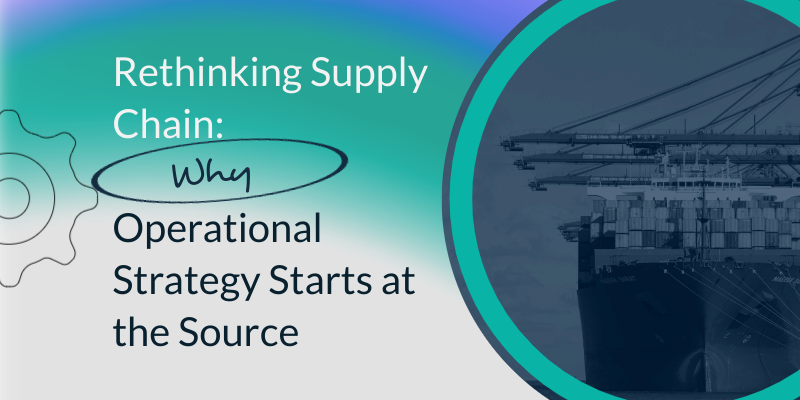Quality in the Modern Age: Bridging Certifications with Tactical Expertise
Certifications have served as a crucial measure of qualification for businesses across the globe. They have provided a level of assurance to customers and stakeholders that a company meets certain industry standards and practices and possesses the tools and framework to understand a problem and solve it. However, as the market landscape continues to evolve and becomes more complex, relying solely on certifications may no longer be sufficient to ensure the long-term success and sustainability of a business.
In today’s dynamic business environment, organizations must not only obtain certifications but also possess the tactical skills and experience needed to continuously identify and address any gaps in their Total Quality Management (TQM) processes. This entails a holistic approach to quality management that goes beyond the traditional certification framework.
To effectively safeguard a business from the risk of failure, it is essential to focus on improving process efficiency and automation. By doing so, organizations can better adapt to changes in the market, environment, and consumer demands. This means moving away from manual workarounds and instead embracing technology-driven solutions that streamline operations, enhance productivity, and minimize errors or bottlenecks.
One major challenge in achieving a comprehensive TQM system is the prevalence of manual workarounds and siloed technology. Many organizations still rely on outdated and inefficient manual processes that lead to redundant tasks, delays, and increased risks. Additionally, various departments within a company often use different technology platforms or systems, creating information silos that hinder collaboration and hinder the overall efficiency and effectiveness of quality management efforts.
To address these issues, businesses must proactively identify and eliminate manual workarounds, replacing them with automated processes and standardized workflows. This can significantly reduce human errors, improve consistency, and optimize resource allocation. Moreover, the integration of technology systems and platforms across different departments or functions is crucial to breaking down silos and promoting seamless communication and collaboration.
While certifications remain important as a quality benchmark, organizations must look beyond them and prioritize process improvement and automation in their TQM approaches. By addressing manual workarounds and implementing integrated technology solutions, businesses can enhance their ability to meet market demands, adapt to changes, and consistently deliver high-quality products or services. This comprehensive approach to quality management will not only help reduce the risk of failure but also establish a strong foundation for long-term success in today’s rapidly changing business landscape.
What you can do
- Process Mapping
Process mapping is an essential tool to understand your end-to-end business processes, identify bottlenecks, and manual workarounds. Embrace this practice in your TQM methodology, and you’ll soon discover that you can identify redundant tasks, mitigate risk, and greatly increase processing efficiency. The process mapping technique helps client-facing employees understand the end-to-end process they are working on and the constraints they should take into account.
To successfully engage in process mapping, it is essential to adopt an objective approach and gain a thorough understanding of the current state of your operations. This means delving into the processes and workflows that are currently in place within your organization. To achieve this, it is crucial to involve the members of your team who are directly involved in the day-to-day tasks and responsibilities. By engaging these individuals, you can gather valuable insights and first-hand knowledge about the inner workings of your operations. Their perspectives will provide a comprehensive and accurate picture of how things are currently functioning. This collaborative approach not only ensures that the process map accurately reflects reality but also fosters a sense of ownership and buy-in from the team members who contribute to its creation. Through this inclusive process, you can uncover any inefficiencies or bottlenecks that may be hindering productivity and identify potential areas for improvement. Ultimately, this objective analysis of the current state of operations is a crucial first step toward implementing meaningful changes that can optimize your processes and drive overall organizational success.
- Integrating Siloed Platforms
Having a comprehensive and well-maintained TQM solution is crucial for all organizations, regardless of their industry or size. Such a solution should include integrated operational backbone solutions that streamline processes and promote efficiency.
In many cases, organizations acquire or merge with other companies, resulting in the need for data migration. As a result, businesses often find themselves with multiple disjointed platforms that cater to different functions or departments. These siloed platforms may house separate versions of the data, which can cause inconsistencies and inaccuracies in the organization’s overall operations.
Companies can address these issues and ensure the safety and robustness of their operations. An integrated solution allows for seamless data integration and eliminates the risk of having fragmented information across various platforms. This, in turn, enhances data accuracy and supports more informed decision-making.
Furthermore, it enables organizations to meet their specific business needs effectively. It provides a centralized system that connects various departments and functions, allowing for better collaboration and coordination. This holistic approach to quality management enhances efficiency, reduces redundant processes, and optimizes resource allocation.
By adopting a comprehensive platform, businesses can ensure the accuracy and reliability of their data, streamline processes, and meet their specific business needs effectively.
- Effective Quality Management Audits
With the evolution of industry and society, businesses are now required to follow stringent quality regulations to survive. Effective quality management audits play a pivotal role in maintaining a compliant and ethical business model. From a TQM perspective, auditing is a process that evaluates the effectiveness of a management system in describing and documenting various processes within an organization. It aims to identify key data points for measurement, record the results obtained from the measurements, and consequently highlight any areas that offer opportunities for further improvement.
The purpose of auditing is to ensure that the management system is comprehensive and accurately represents the processes and procedures implemented within the organization. It assesses whether the system adequately captures all the relevant information and data required for measuring performance and evaluating overall quality.
By conducting audits, organizations gain insights into the strengths and weaknesses of their management systems. Auditors examine various aspects such as process documentation, data collection methods, and the accuracy of recorded results. Through this evaluation, they can pinpoint areas that require refinement, revision, or optimization.
The identification of areas of opportunity for improvement is a crucial outcome of auditing. It allows organizations to address potential shortcomings and implement necessary changes to enhance the efficiency and effectiveness of their management systems. This continuous improvement approach is a fundamental principle of TQM, as it ensures that organizations constantly strive for higher levels of quality and performance.
Auditing from a TQM viewpoint is a systematic process that evaluates the effectiveness of a management system in accurately describing processes, identifying measurement data points, recording results, and highlighting areas for improvement. It provides organizations with valuable insights to enhance their overall quality and performance.
- Artificial Intelligence
Artificial intelligence (AI) has emerged at the forefront of technological advancements and is poised to revolutionize various industries. This disruptive technology is rapidly gaining popularity and attention for its remarkable ability to learn and make informed decisions based on a data-driven approach. By inputting vast amounts of data into sophisticated AI algorithms, it becomes possible to generate complex predictive analyses and develop alert systems that can effectively detect deviations from regular processes and promptly flag potential compliance and quality issues, all in real-time.
The value of AI lies in its capacity to analyze large and diverse sets of data with exceptional speed and accuracy. It can process vast amounts of information in a fraction of the time it would take for human analysis. By constantly learning and adapting, AI systems can continuously improve their decision-making capabilities, offering valuable insights and recommendations. This innovative technology has immense potential across various sectors, including finance, healthcare, manufacturing, and transportation.
Examples:
In finance, AI can be deployed to analyze market trends, predict stock price movements, and identify investment opportunities. By scrutinizing historical data and considering various market factors, AI-based algorithms can offer valuable insights for achieving superior financial outcomes. Similarly, in healthcare, AI can assist in diagnosing diseases, analyzing medical images, and predicting patients’ responses to specific treatments. This can lead to more accurate diagnoses, personalized treatment plans, and improved patient outcomes.
In manufacturing, AI can optimize production processes, predict equipment failures, and enhance supply chain management. By analyzing real-time data from sensors, AI systems can identify potential issues and suggest preventive measures, reducing downtime and improving operational efficiency. Moreover, in the transportation sector, AI can play a crucial role in autonomous vehicles, improving road safety and optimizing traffic flow. AI-powered systems can analyze real-time traffic data, predict congestion patterns, and suggest alternative routes, enhancing the overall travel experience.
The potential of AI is vast and promising, paving the way for new possibilities and innovations. However, it is essential to ensure ethical considerations and address potential challenges, such as data privacy and bias. With the right approach and responsible implementation, artificial intelligence has the potential to transform industries, drive economic growth, and improve the lives of people worldwide.
- Continuous Improvement
The last method to address manual workarounds and siloed technology in TQM is continuous improvement. Continuous improvement is a fundamental philosophy adopted by many businesses and organizations to enhance their performance and practices over time. It is an iterative approach that encourages learning and growth through experimentation and innovation. By continuously seeking ways to improve, businesses aim to achieve higher levels of efficiency, productivity, and overall success.
To facilitate continuous improvement within TQM systems, certain elements are essential. One such element is the provision of data-driven review and analysis. Accessing and analyzing relevant data allows businesses to identify areas of weakness or inefficiency, as well as areas of strength, which can then influence decision-making processes. By utilizing this data, companies can pinpoint areas that require improvement and develop action plans accordingly.
Feedback is another crucial aspect of supporting continuous improvement in TQM systems. Ongoing communication between employees, managers, and stakeholders enables the sharing of valuable insights and suggestions for improvement. Constructive feedback not only helps individuals and teams understand areas where improvements are required but also encourages a culture of continuous learning and growth.
Accountability is vital for driving continuous improvement efforts. Organizations must establish clear responsibilities and expectations to ensure that employees at all levels take ownership of their work and actively contribute to the organization’s improvement goals. By holding individuals and teams accountable for their performance, organizations can foster a sense of responsibility, motivation, and commitment to continuously seek better ways of doing things. If you want help designing a TQM framework, contact one of our consultants today.







